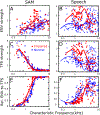Underlying neural mechanisms of degraded speech intelligibility following noise-induced hearing loss: The importance of distorted tonotopy
- PMID: 35953357
- PMCID: PMC11149709
- DOI: 10.1016/j.heares.2022.108586
Underlying neural mechanisms of degraded speech intelligibility following noise-induced hearing loss: The importance of distorted tonotopy
Abstract
Listeners with sensorineural hearing loss (SNHL) have substantial perceptual deficits, especially in noisy environments. Unfortunately, speech-intelligibility models have limited success in predicting the performance of listeners with hearing loss. A better understanding of the various suprathreshold factors that contribute to neural-coding degradations of speech in noisy conditions will facilitate better modeling and clinical outcomes. Here, we highlight the importance of one physiological factor that has received minimal attention to date, termed distorted tonotopy, which refers to a disruption in the mapping between acoustic frequency and cochlear place that is a hallmark of normal hearing. More so than commonly assumed factors (e.g., threshold elevation, reduced frequency selectivity, diminished temporal coding), distorted tonotopy severely degrades the neural representations of speech (particularly in noise) in single- and across-fiber responses in the auditory nerve following noise-induced hearing loss. Key results include: 1) effects of distorted tonotopy depend on stimulus spectral bandwidth and timbre, 2) distorted tonotopy increases across-fiber correlation and thus reduces information capacity to the brain, and 3) its effects vary across etiologies, which may contribute to individual differences. These results motivate the development and testing of noninvasive measures that can assess the severity of distorted tonotopy in human listeners. The development of such noninvasive measures of distorted tonotopy would advance precision-audiological approaches to improving diagnostics and rehabilitation for listeners with SNHL.
Keywords: Auditory nerve; Distorted tonotopy; Hearing loss; Speech coding; Speech intelligibility; Temporal coding.
Copyright © 2022. Published by Elsevier B.V.
Conflict of interest statement
Declaration of Competing Interest The authors declare no competing interests.
Figures










Similar articles
-
Distorted Tonotopy Severely Degrades Neural Representations of Connected Speech in Noise following Acoustic Trauma.J Neurosci. 2022 Feb 23;42(8):1477-1490. doi: 10.1523/JNEUROSCI.1268-21.2021. Epub 2022 Jan 4. J Neurosci. 2022. PMID: 34983817 Free PMC article.
-
Auditory models of suprathreshold distortion and speech intelligibility in persons with impaired hearing.J Am Acad Audiol. 2013 Apr;24(4):307-28. doi: 10.3766/jaaa.24.4.6. J Am Acad Audiol. 2013. PMID: 23636211
-
Understanding excessive SNR loss in hearing-impaired listeners.J Am Acad Audiol. 2013 Apr;24(4):258-73; quiz 337-8. doi: 10.3766/jaaa.24.4.3. J Am Acad Audiol. 2013. PMID: 23636208
-
Why do I hear but not understand? Stochastic undersampling as a model of degraded neural encoding of speech.Front Neurosci. 2014 Oct 30;8:348. doi: 10.3389/fnins.2014.00348. eCollection 2014. Front Neurosci. 2014. PMID: 25400543 Free PMC article. Review.
-
Transducer Variability in Speech-in-Noise Testing: Considerations Related to Stimulus Bandwidth.Am J Audiol. 2024 Sep 3;33(3):1070-1076. doi: 10.1044/2024_AJA-24-00055. Epub 2024 Jul 12. Am J Audiol. 2024. PMID: 38995872 Review.
Cited by
-
Intelligibility Sound Therapy Enhances the Ability of Speech-in-Noise Perception and Pre-Perceptual Neurophysiological Response.Biology (Basel). 2024 Dec 6;13(12):1021. doi: 10.3390/biology13121021. Biology (Basel). 2024. PMID: 39765688 Free PMC article.
-
Bursts of vagus nerve stimulation paired with auditory rehabilitation fail to improve speech sound perception in rats with hearing loss.iScience. 2024 Mar 19;27(4):109527. doi: 10.1016/j.isci.2024.109527. eCollection 2024 Apr 19. iScience. 2024. PMID: 38585658 Free PMC article.
-
Altered neural encoding of vowels in noise does not affect behavioral vowel discrimination in gerbils with age-related hearing loss.Front Neurosci. 2023 Nov 14;17:1238941. doi: 10.3389/fnins.2023.1238941. eCollection 2023. Front Neurosci. 2023. PMID: 38033551 Free PMC article.
-
Impact of reduced spectral resolution on temporal-coherence-based source segregation.J Acoust Soc Am. 2024 Dec 1;156(6):3862-3876. doi: 10.1121/10.0034545. J Acoust Soc Am. 2024. PMID: 39655945
-
Impact of Reduced Spectral Resolution on Temporal-Coherence-Based Source Segregation.bioRxiv [Preprint]. 2024 Mar 13:2024.03.11.584489. doi: 10.1101/2024.03.11.584489. bioRxiv. 2024. Update in: J Acoust Soc Am. 2024 Dec 1;156(6):3862-3876. doi: 10.1121/10.0034545. PMID: 38586037 Free PMC article. Updated. Preprint.
References
-
- Bharadwaj HM, Verhulst S, Shaheen L, Liberman MC, Shinn-Cunningham BG, 2014. Cochlear neuropathy and the coding of supra-threshold sound. Front. Syst. Neurosci. 8. 10.3389/fnsys.2014.00026 - DOI
-
- Bruce IC, Zilany MSA, 2007. Modelling the effects of cochlear impairment on the neural representation of speech in the auditory nerve and primary auditory cortex. Proceedings of the International Symposium on Auditory and Audiological Research 1, 1–10.
Publication types
MeSH terms
Grants and funding
LinkOut - more resources
Full Text Sources

